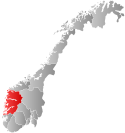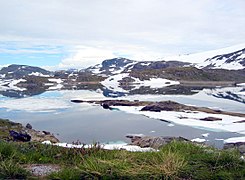|
Luster, Norway
Luster is a municipality in Vestland county, Norway. It is located at the end of the Sognefjorden in the traditional district of Sogn. The administrative centre is the village of Gaupne. Other villages in Luster include Fortun, Hafslo, Indre Hafslo, Jostedal, Luster, Nes, Ornes, Skjolden, Solvorn, and Veitastrond. Luster is centered around the inner branch of the Sognefjord, which is called the Lustrafjorden. Its landscape includes fjords, steep mountains, water-abundant waterfalls, blue glaciers, and valleys. Both Jostedalsbreen National Park and Breheimen National Park are partially located in this municipality. The Sognefjellsvegen road goes over a mountain pass in eastern Luster. The 2,706-square-kilometre (1,045 sq mi) municipality is the 17th largest by area out of the 356 municipalities in Norway. Luster is the 176th most populous municipality in Norway with a population of 5,302. The municipality's population density is 2 inhabitants per square kilometre (5.2/sq mi) and its population has increased by 5.2% during the previous 10-year period.[4][5] In 2016, the chief of police for Vestlandet formally suggested a reconfiguration of police districts and stations. He proposed that the police station in Luster be closed.[6] General information   Lyster was established as a municipality on 1 January 1838 (see formannskapsdistrikt law). The original municipality was identical to the Lyster parish (prestegjeld) with the sub-parishes (sokn) of Fortun, Dale, Nes, and Gaupne. During the 1960s, there were many municipal mergers across Norway due to the work of the Schei Committee. On 1 January 1963, the neighboring municipalities of Hafslo and Jostedal were merged with Luster, forming a much larger municipality. After the merger, Luster had 5,854 residents.[7] Since the consolidation of the three municipalities of Hafslo, Jostedal and Luster in 1963, the area has been characterized by scattered rural settlements and large distances between these settlements. Luster was the largest municipality by area in the old Sogn og Fjordane county.[8] On 1 January 2020, the municipality became part of the newly created Vestland county after Sogn og Fjordane and Hordaland counties were merged. NameThe municipality (originally the parish) is named after the Lustrafjorden (Old Norse: Lústr) and the village of Luster which grew up along the fjord. The name is derived from the word ljóss which means "light" or "bright", referring to the bright color of the water from the glaciers.[9] Historically, the name of the municipality was spelled Lyster. On 3 November 1917, a royal resolution changed the spelling of the name of the municipality to Luster.[10] Coat of armsThe coat of arms was granted on 20 April 1990. The official blazon is "Azure, a tilia curled argent forming an annulet" (Norwegian: På blå grunn ein sølv linderanke lagt i sirkel). This means the arms have a blue field (background) and the charge is a tilia branch curled into a circle. The charge has a tincture of argent which means it is commonly colored white, but if it is made out of metal, then silver is used. The arms are inspired by an old woodcarving found in the Urnes Stave Church which is located in the municipality. The arms were designed by Inge Rotevatn from Nordfjordeid. The municipal flag has the same design as the coat of arms.[11][12][13] ChurchesThe Church of Norway has eight parishes (sokn) within the municipality of Luster. It is part of the Sogn prosti (deanery) in the Diocese of Bjørgvin.[14]
Government Luster Municipality is responsible for primary education (through 10th grade), outpatient health services, senior citizen services, welfare and other social services, zoning, economic development, and municipal roads and utilities. The municipality is governed by a municipal council of directly elected representatives. The mayor is indirectly elected by a vote of the municipal council.[15] The municipality is under the jurisdiction of the Sogn og Fjordane District Court and the Gulating Court of Appeal. Municipal councilThe municipal council (Kommunestyre) of Luster is made up of 25 representatives that are elected to four year terms. The tables below show the current and historical composition of the council by political party.
Mayors
Geography  LocationLuster, one of the largest municipalities in southern Norway, is located in the glacial mountains where the Sognefjorden begins its path to the North Sea. The fjord is fed by many large glaciers such as the Harbardsbreen, Holåbreen, Jostedalsbreen, Nigardsbreen, Spørteggbreen, and others.[37] It is bordered by four municipalities in Vestland county: Stryn to the north, Sunnfjord to the west, Sogndal to the southwest, and Årdal to the southeast. It is also bordered by three municipalities in Innlandet county: Skjåk to the northeast and by Lom and Vang to the east. Feigumfoss waterfallWith a vertical drop of 218 metres (715 ft), the Feigumfoss Waterfall is one of the highest in Scandinavia.[38] MountainsThe Hurrungane, Breheimen, and Jotunheimen mountains cover parts of the municipality. Store Skagastølstind (or Storen) is the third highest mountain peak in Norway at 2,405 metres (7,890 ft) high, and it is located on the southern border of Luster and Årdal. It is part of the Hurrungane mountain range which contains some of the most alpine peaks in Norway.
Lakes and RiversThere are notable lakes such as Veitastrondsvatnet, Austdalsvatnet, Styggevatnet, Tunsbergdalvatnet, Prestesteinsvatnet, and Hafslovatnet. There are also many big waterfalls such as the Feigumfoss waterfall at 218 metres (715 ft) tall. The river Jostedøla runs through the Jostedal valley and empties into the fjord at Gaupne.  GlaciersThe Jostedalsbreen glacier (including the arm called Nigardsbreen) is the biggest glacier in continental Europe, the highest point on it is Høgste Breakulen. It is located west of Jostedal, north of Gaupne, in Jostedalsbreen National Park, much of which is located in the municipality of Luster.[38] Other glaciers include the Austerdalsbreen, Harbardsbreen and Spørteggbreen. EconomyThe inhabitants of Luster make their living by farming, growing berries and fruit, tourism, and hydroelectricity. Jøstedal and Fortun have large hydroelectric power stations. Summer tourism is quite busy. Tourist activities include mountain climbing, skiing, fishing, hiking, and hunting.[38] The Sognefjellsvegen tourist road passes through Luster. River fishingFishing permits (for salmon fishing) are sold for use on specific rivers, including Årøy-elva.[39] Culture and educationHistoric churches
Urnes Stave Church was built around 1150 and is Norway's oldest Stave church. The Church lies majestically on the top of Urnes. The Stave church is one of four Norwegian Churches on UNESCO`s list of the most precious cultural monuments in the world. The Stave churches are constructions of high quality, richly decorated with carvings. In virtually all of them the door frames are decorated from top to bottom with carvings. This tradition of rich ornamentation appears to go back to the animal carvings of the Viking age. The dragons are lovingly executed and transformed into long-limbed creatures of fantasy, here and there entwined with tendrils of vine, with winding stems and serrated leaves. The elaborate designs are executed with supreme artistic skill. The stave church doorways are, therefore, among the most distinctive works of art to be found in Norway. However, it is difficult to connect them with the Christian gospel.[38]
The Old Gaupne Church is a magnificent church that was built in 1647 on a hill directly opposite Gaupne centre.[38]
Dale Church is a stone church that was built in gothic style in the year 1250.[38] Breheim centerThe Breheim Center contains a comprehensive exhibition. A journey through 20,000 years - from the Ice age to the present day, an audio/visual show takes visitors inside the glacier. Glacier boat M/S "Jostedalsrypa" crosses the Nigard Glacier Lake. There are internationally approved guides, glacier and climbing courses, and ski-trips.[38] EducationIn 2020, 32% of the municipality's applicants for [secondary schooling] videregående skole, sought [non-vocational schooling], studiespesialisering; [67% or] the rest of the applicants sought vocational schooling.[40] Notable people
Twin cities/townsLuster has sister city agreements with the following places: Media gallery
References
External linksWikimedia Commons has media related to Luster, Norway.
|
||||||||||||||||||||||||||||||||||||||||||||||||||||||||||||||||||||||||||||||||||||||||||||||||||||||||||||||||||||||||||||||||||||||||||||||||||||||||||||||||||||||||||||||||||||||||||||||||||||||||||||||||||||||||||||||||||||||||||||||||||||||||||||||||||||||||||||||||||||||||||||||||||||||||||||||||||||||||||||||||||||||||||||||||||||||||||||||||||||||||||||||||||||||||||||||||||||||||||||||||||||||||||||||||||||||||||||||||||||||||||||||||||||||||||||||||||||||||||||||||||||||||||||||||||||||||||||||||||||||||||||||||||||||||||||||||||||||||||||||||||||||||||||||||||||||||||||||||||||||||||||||||||||||||||||||||||||||||||||||||||||||||||||||













